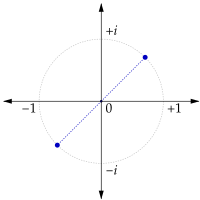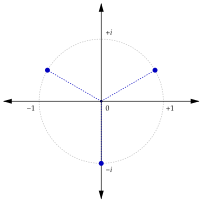The imaginary unit or unit imaginary number (i) is a solution to the quadratic equation x2 + 1 = 0. Although there is no real number with this property, i can be used to extend the real numbers to what are called complex numbers, using addition and multiplication. A simple example of the use of i in a complex number is 2 + 3i.
Imaginary numbers are an important mathematical concept, which extend the real number system ℝ to the complex number system ℂ, which in turn provides at least one root for every nonconstant polynomial P(x). The term "imaginary" is used because there is no real number having a negative square.
There are two complex square roots of −1, namely i and −i, just as there are two complex square roots of every real number other than zero, which has one double square root.
In contexts where i is ambiguous or problematic, j or the Greek ι is sometimes used. In the disciplines of electrical engineering and control systems engineering, the imaginary unit is normally denoted by j instead of i, because i is commonly used to denote electric current.
Definition
| The powers of i return cyclic values: |
|---|
| ... (repeats the pattern from blue area) |
| i−3 = i |
| i−2 = −1 |
| i−1 = −i |
| i0 = 1 |
| i1 = i |
| i2 = −1 |
| i3 = −i |
| i4 = 1 |
| i5 = i |
| i6 = −1 |
| ... (repeats the pattern from the blue area) |
Although the construction is called "imaginary", and although the concept of an imaginary number may be intuitively more difficult to grasp than that of a real number, the construction is perfectly valid from a mathematical standpoint. Real number operations can be extended to imaginary and complex numbers by treating i as an unknown quantity while manipulating an expression, and then using the definition to replace any occurrence of i2 with −1. Higher integral powers of i can also be replaced with −i, 1, i, or −1:
i and −i
Being a quadratic polynomial with no multiple root, the defining equation x2 = −1 has two distinct solutions, which are equally valid and which happen to be additive and multiplicative inverses of each other. More precisely, once a solution i of the equation has been fixed, the value −i, which is distinct from i, is also a solution. Since the equation is the only definition of i, it appears that the definition is ambiguous (more precisely, not well-defined). However, no ambiguity results as long as one or other of the solutions is chosen and labelled as "i", with the other one then being labelled as −i.This is because, although −i and i are not quantitatively equivalent (they are negatives of each other), there is no algebraic difference between i and −i. Both imaginary numbers have equal claim to being the number whose square is −1. If all mathematical textbooks and published literature referring to imaginary or complex numbers were rewritten with −i replacing every occurrence of +i (and therefore every occurrence of −i replaced by −(−i) = +i), all facts and theorems would continue to be equivalently valid. The distinction between the two roots x of x2 + 1 = 0 with one of them labelled with a minus sign is purely a notational relic; neither root can be said to be more primary or fundamental than the other, and neither of them is "positive" or "negative".
The issue can be a subtle one. The most precise explanation is to say that although the complex field, defined as ℝ[x]/(x2 + 1) (see complex number), is unique up to isomorphism, it is not unique up to a unique isomorphism — there are exactly two field automorphisms of ℝ[x]/(x2 + 1) which keep each real number fixed: the identity and the automorphism sending x to −x.
Matrices
A similar issue arises if the complex numbers are interpreted as 2 × 2 real matrices, because then bothand
All these ambiguities can be solved by adopting a more rigorous definition of complex number, and explicitly choosing one of the solutions to the equation to be the imaginary unit. For example, the ordered pair (0, 1), in the usual construction of the complex numbers with two-dimensional vectors.
When the set of 2 × 2 real matrices M (2, ℝ) is used for a source, and the number one (1) is identified with the identity matrix, and minus one (−1) with the negative of the identity matrix, then there are many solutions to X 2 = −1. In fact, there are many solutions to X 2 = +1 and X 2 = 0 also. Any such X can be taken as a basis vector, along with 1, to form a planar subalgebra
Proper use
The imaginary unit is sometimes written √−1 in advanced mathematics contexts (as well as in less advanced popular texts). However, great care needs to be taken when manipulating formulas involving radicals. The radical sign notation is reserved either for the principal square root function, which is only defined for real x ≥ 0, or for the principal branch of the complex square root function. Attempting to apply the calculation rules of the principal (real) square root function to manipulate the principal branch of the complex square root function can produce false results:(incorrect).
(incorrect).
These problems are avoided by writing and manipulating expressions like i√7, rather than √−7.
Properties
Square roots
The two square roots of i in the complex plane
The three cube roots of i in the complex plane
i has two square roots, just like all complex numbers (except zero, which has a double root). These two roots can be expressed as the complex numbers:
Cube roots
The three cube roots of i are:Multiplication and division
Multiplying a complex number by i gives:Dividing by i is equivalent to multiplying by the reciprocal of i:
Powers
The powers of i repeat in a cycle expressible with the following pattern, where n is any integer:i raised to the power of i
Making use of Euler's formula, ii is , the set of integers.
, the set of integers.The principal value (for k = 0) is e−π/2 or approximately 0.207879576...
Factorial
The factorial of the imaginary unit i is most often given in terms of the gamma function evaluated at 1 + i:Other operations
Many mathematical operations that can be carried out with real numbers can also be carried out with i, such as exponentiation, roots, logarithms, and trigonometric functions. All of the following functions are complex multi-valued functions, and it should be clearly stated which branch of the Riemann surface the function is defined on in practice. Listed below are results for the most commonly chosen branch.A number raised to the ni power is:
The cosine of i is a real number:
Alternative notations
- In electrical engineering and related fields, the imaginary unit is normally denoted by j to avoid confusion with electric current as a function of time, traditionally denoted by i(t) or just i. The Python programming language also uses j to mark the imaginary part of a complex number. MATLAB associates both i and j with the imaginary unit, although 1i or 1j is preferable, for speed and improved robustness.
- Some texts use the Greek letter iota (ι) for the imaginary unit, to avoid confusion, especially with index and subscripts.
- Each of i, j, and k is an imaginary unit in the quaternions. In bivectors and biquaternions an additional imaginary unit h is used.
































![{\displaystyle {\sqrt[{ni}]{x}}=\cos \left({\frac {\ln x}{n}}\right)-i\sin \left({\frac {\ln x}{n}}\right).}](https://wikimedia.org/api/rest_v1/media/math/render/svg/3910da36e0378d5697237c8f581fe6565eba9aa1)

